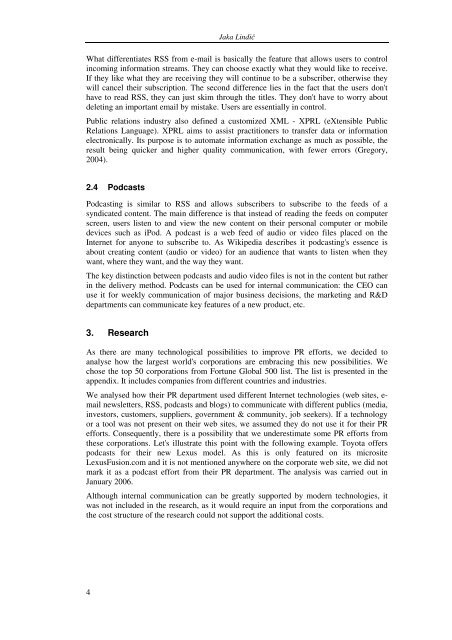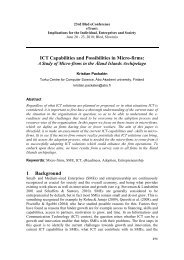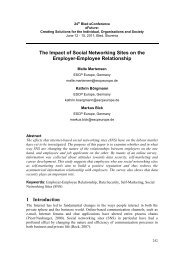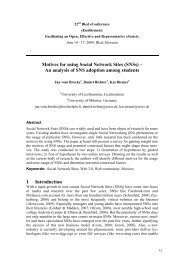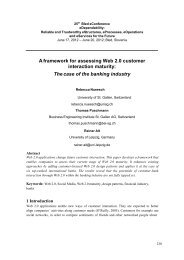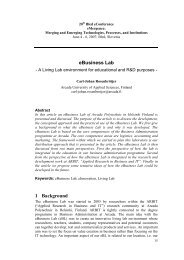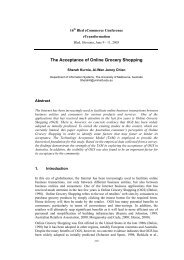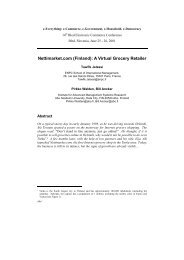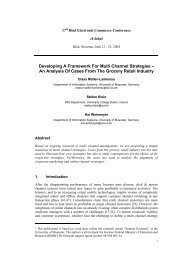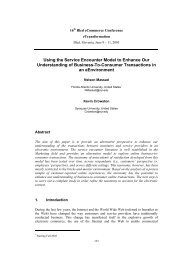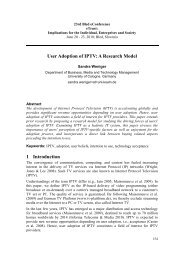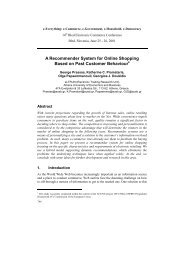How Do Corporations Use Internet for Public Relations?
How Do Corporations Use Internet for Public Relations?
How Do Corporations Use Internet for Public Relations?
You also want an ePaper? Increase the reach of your titles
YUMPU automatically turns print PDFs into web optimized ePapers that Google loves.
4<br />
Jaka Lindič<br />
What differentiates RSS from e-mail is basically the feature that allows users to control<br />
incoming in<strong>for</strong>mation streams. They can choose exactly what they would like to receive.<br />
If they like what they are receiving they will continue to be a subscriber, otherwise they<br />
will cancel their subscription. The second difference lies in the fact that the users don't<br />
have to read RSS, they can just skim through the titles. They don't have to worry about<br />
deleting an important email by mistake. <strong>Use</strong>rs are essentially in control.<br />
<strong>Public</strong> relations industry also defined a customized XML - XPRL (eXtensible <strong>Public</strong><br />
<strong>Relations</strong> Language). XPRL aims to assist practitioners to transfer data or in<strong>for</strong>mation<br />
electronically. Its purpose is to automate in<strong>for</strong>mation exchange as much as possible, the<br />
result being quicker and higher quality communication, with fewer errors (Gregory,<br />
2004).<br />
2.4 Podcasts<br />
Podcasting is similar to RSS and allows subscribers to subscribe to the feeds of a<br />
syndicated content. The main difference is that instead of reading the feeds on computer<br />
screen, users listen to and view the new content on their personal computer or mobile<br />
devices such as iPod. A podcast is a web feed of audio or video files placed on the<br />
<strong>Internet</strong> <strong>for</strong> anyone to subscribe to. As Wikipedia describes it podcasting's essence is<br />
about creating content (audio or video) <strong>for</strong> an audience that wants to listen when they<br />
want, where they want, and the way they want.<br />
The key distinction between podcasts and audio video files is not in the content but rather<br />
in the delivery method. Podcasts can be used <strong>for</strong> internal communication: the CEO can<br />
use it <strong>for</strong> weekly communication of major business decisions, the marketing and R&D<br />
departments can communicate key features of a new product, etc.<br />
3. Research<br />
As there are many technological possibilities to improve PR ef<strong>for</strong>ts, we decided to<br />
analyse how the largest world's corporations are embracing this new possibilities. We<br />
chose the top 50 corporations from Fortune Global 500 list. The list is presented in the<br />
appendix. It includes companies from different countries and industries.<br />
We analysed how their PR department used different <strong>Internet</strong> technologies (web sites, email<br />
newsletters, RSS, podcasts and blogs) to communicate with different publics (media,<br />
investors, customers, suppliers, government & community, job seekers). If a technology<br />
or a tool was not present on their web sites, we assumed they do not use it <strong>for</strong> their PR<br />
ef<strong>for</strong>ts. Consequently, there is a possibility that we underestimate some PR ef<strong>for</strong>ts from<br />
these corporations. Let's illustrate this point with the following example. Toyota offers<br />
podcasts <strong>for</strong> their new Lexus model. As this is only featured on its microsite<br />
LexusFusion.com and it is not mentioned anywhere on the corporate web site, we did not<br />
mark it as a podcast ef<strong>for</strong>t from their PR department. The analysis was carried out in<br />
January 2006.<br />
Although internal communication can be greatly supported by modern technologies, it<br />
was not included in the research, as it would require an input from the corporations and<br />
the cost structure of the research could not support the additional costs.


